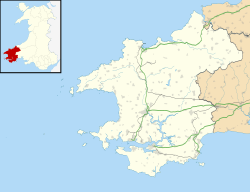Treffgarne
| |
|---|---|
 Church of St Michael | |
Location within Pembrokeshire | |
| OS grid reference | SM956237 |
| Community | |
| Principal area | |
| Preserved county | |
| Country | Wales |
| Sovereign state | United Kingdom |
| Post town | HAVERFORDWEST |
| Postcode district | SA62 |
| Dialling code | 01437 |
| Police | Dyfed-Powys |
| Fire | Mid and West Wales |
| Ambulance | Welsh |
| UK Parliament | |
| Senedd Cymru – Welsh Parliament | |
Treffgarne (Welsh : Trefgarn, or town of the rock) is a small village and parish in Pembrokeshire, south-west Wales. It lies to the south of the Preseli Hills close to the Western Cleddau river, and close to the main A40 road from Fishguard to Haverfordwest. The area has an interesting local geology and evidence of mineral extraction at least as far back as Roman times. The present village is medieval in origin.
